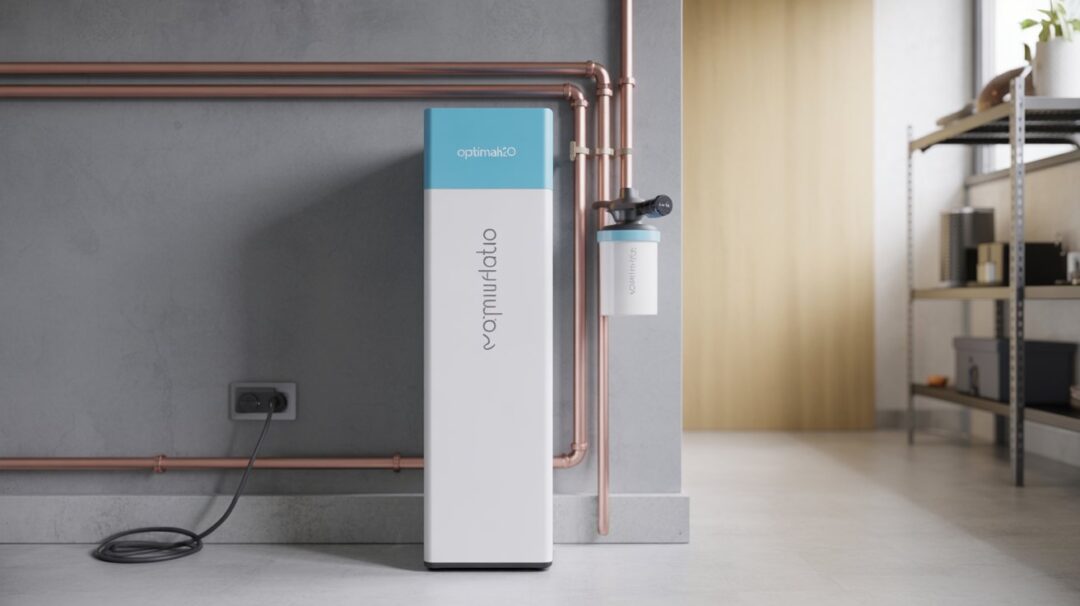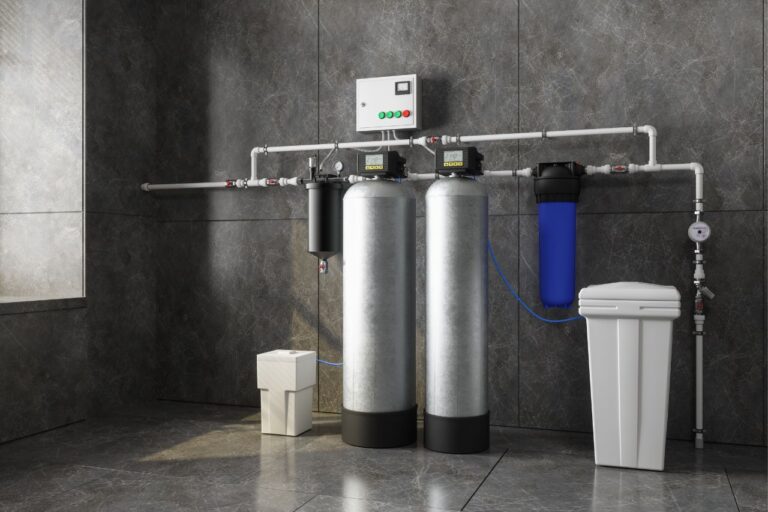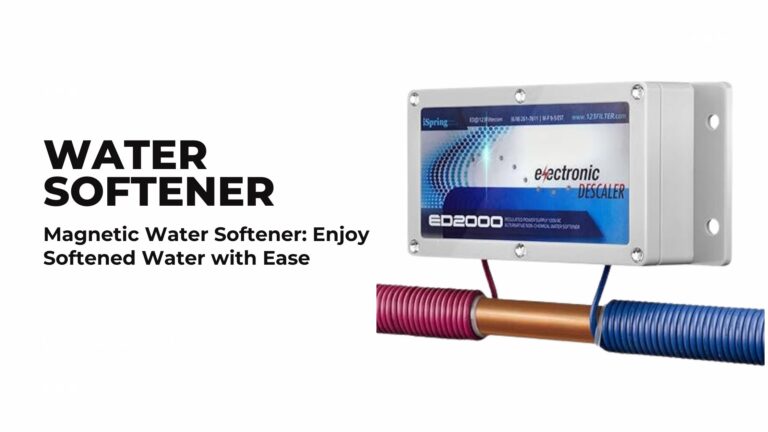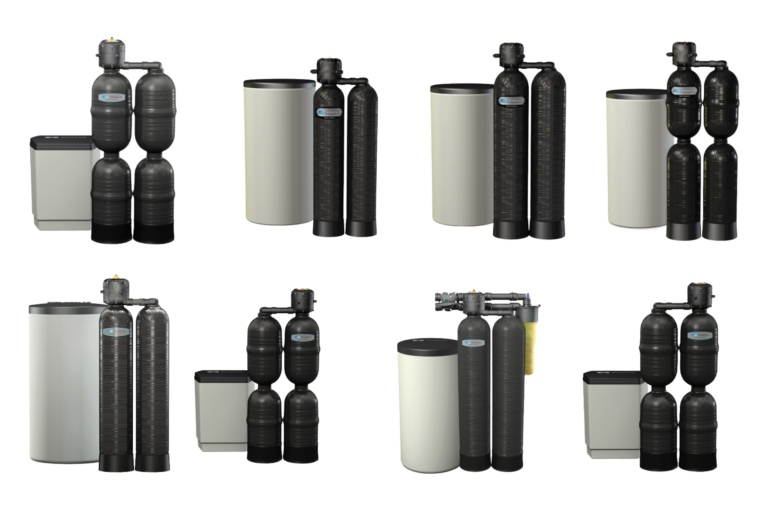Are You Getting the Most Out of Your Home Water Softener?
When it comes to maintaining a water softener, the regeneration process is crucial for its efficiency in removing hardness minerals. But have you ever wondered how your water softener knows when to regenerate? Demand-Initiated Regeneration (DIR) is a technology that makes this process more efficient.
This technology continuously monitors water flow and initiates regeneration only when necessary, making it a cost-effective and efficient solution for homeowners.
Key Takeaways
- DIR technology regenerates the water softener based on actual water usage.
- It reduces salt and water consumption by regenerating only when needed.
- Some advanced DIR systems have dual tanks, ensuring uninterrupted soft water supply.
- DIR adjusts to varying water usage patterns, making it ideal for homes with fluctuating demands.
- It reduces operational costs over time by minimizing unnecessary regeneration cycles.
Understanding Hard Water and Water Softening Basics
Hard water is a common issue in many American households, causing problems with plumbing and appliances. It’s characterized by high levels of calcium and magnesium ions, which can lead to scaling in pipes and reduced efficiency of water-using appliances.
The Problem with Hard Water in American Homes
Hard water can cause significant issues, including reducing the lifespan of appliances and pipes due to scaling. This not only leads to increased maintenance costs but also results in higher energy bills due to reduced appliance efficiency.
How Traditional Water Softeners Work
Traditional water softeners use ion exchange technology to remove calcium and magnesium ions, replacing them with sodium or potassium ions. This process softens the water, preventing scaling and improving appliance efficiency.
The Evolution of Water Softening Technology
The technology behind water softening has evolved significantly, leading to the development of more efficient systems like DIR water softeners. Understanding the regeneration process in these modern systems is crucial for appreciating their benefits.
| Technology | Key Features | Benefits |
|---|---|---|
| Traditional Water Softeners | Ion exchange technology | Softens water, prevents scaling |
| DIR Water Softeners | Demand-initiated regeneration | Efficient regeneration, water conservation |
By understanding how hard water affects homes and how water softening technology has evolved, homeowners can make informed decisions about their water treatment needs.
What is DIR (Demand-Initiated Regeneration) in Home Water Softeners?
Demand-Initiated Regeneration (DIR) is revolutionizing the way home water softeners operate, offering a more efficient and effective solution to hard water problems. Unlike traditional timer-based systems, DIR technology regenerates based on actual water usage, ensuring that the water softener operates only when necessary.
Definition and Core Concept of DIR
DIR stands for Demand-Initiated Regeneration, a technology that allows water softeners to regenerate based on the actual demand or usage. This approach contrasts with traditional timer-based systems that regenerate on a fixed schedule, regardless of the water usage. The core concept of DIR revolves around optimizing the regeneration process to match the household’s water needs.
How DIR Differs from Timer-Based Systems
The primary difference between DIR and timer-based systems lies in their regeneration triggers. Timer-based systems regenerate at set intervals, which can lead to unnecessary regenerations if water usage is low. In contrast, DIR systems monitor water usage and initiate regeneration only when the resin capacity is depleted, thus optimizing salt and water usage.
- Efficient Regeneration: DIR systems regenerate based on actual water usage.
- Water Conservation: By regenerating only when necessary, DIR systems help conserve water.
- Salt Efficiency: DIR technology also optimizes salt usage by ensuring that regeneration occurs only when the resin is fully depleted.
The Smart Technology Behind DIR
The smart technology behind DIR involves advanced metering or sensing capabilities that monitor water usage and resin capacity. This information is used to determine when regeneration is necessary, ensuring that the water softener operates efficiently and effectively. Some DIR systems come equipped with Wi-Fi connectivity, allowing homeowners to monitor and control their water softeners remotely through mobile apps.
By understanding and leveraging DIR technology, homeowners can enjoy the benefits of softened water while minimizing their environmental footprint. The intelligent regeneration process ensures that water softeners are used optimally, providing consistent soft water supply while conserving resources.
How DIR Water Softeners Actually Work
At the heart of DIR water softeners lies a complex system that ensures optimal water softening through demand-initiated regeneration. This technology is designed to monitor and respond to the actual water usage in a household, making it a more efficient and effective solution compared to traditional timer-based systems.
The Regeneration Process Explained
The regeneration process in DIR water softeners is initiated based on the actual demand for soft water. This process involves recharging the resin beads that remove calcium and magnesium ions from the water, thus softening it. The regeneration process is crucial for maintaining the effectiveness of the water softener.
Monitoring Water Usage and Resin Capacity
DIR water softeners are equipped with a built-in flow meter that tracks water usage and monitors the resin capacity. This information is used to determine when the resin needs to be regenerated. By continuously monitoring water usage patterns, DIR systems can optimize the regeneration process, ensuring that the water softener operates efficiently.
Triggering Factors for Regeneration
The primary factor that triggers regeneration in DIR water softeners is the depletion of the resin capacity, which is directly related to the amount of water processed. When the resin capacity falls below a certain threshold, the system initiates regeneration to restore the softening capability. This approach ensures that regeneration occurs only when necessary, thereby conserving water and salt.
By understanding how DIR water softeners work, homeowners can appreciate the benefits of this advanced technology in providing a reliable supply of soft water while minimizing waste and operational costs.
Types of DIR Mechanisms in Modern Water Softeners
DIR mechanisms in contemporary water softeners offer a range of benefits, including improved water efficiency. Modern DIR systems employ various mechanisms to optimize water softening, catering to different household needs and preferences.
Meter-Based DIR Systems
Meter-based DIR systems monitor the volume of water treated by the softener, regenerating the resin when a predetermined amount of water has been processed. This approach ensures that regeneration occurs based on actual water usage, rather than on a fixed schedule. The key advantage of meter-based systems is their ability to adapt to varying water demands, making them efficient for households with fluctuating occupancy or water usage patterns.
Sensor-Based DIR Systems
Sensor-based DIR systems utilize advanced sensors to monitor the condition of the resin and the water quality in real-time. These systems can detect changes in water hardness and adjust the regeneration process accordingly. This technology provides a more precise and responsive approach to water softening, ensuring that the water remains soft and the system operates efficiently.
Hybrid DIR Technologies
Hybrid DIR technologies combine elements of both meter-based and sensor-based systems, offering a comprehensive solution that leverages the strengths of both approaches. These systems can monitor water usage and quality, adjusting the regeneration process to optimize performance and efficiency. Hybrid DIR systems represent a cutting-edge solution in water softening technology, providing households with a highly adaptable and efficient water treatment system.
In conclusion, the various DIR mechanisms available in modern water softeners offer households a range of options for improving water efficiency and softening performance. By understanding the different types of DIR systems, consumers can make informed decisions when selecting a water softener that meets their specific needs.
Comparing DIR with Other Regeneration Methods
DIR, or Demand-Initiated Regeneration, is revolutionizing the way water softeners operate, but how does it compare to other regeneration methods? Traditional water softeners have relied on timer-based or manual regeneration methods, each with its own set of limitations.
Timer-Based Regeneration Limitations
Timer-based regeneration systems regenerate the water softener at fixed intervals, regardless of the actual water usage. This can lead to inefficiencies, as the system may regenerate when it’s not necessary, wasting water and salt. For instance, if a household has been away on vacation, the timer-based system will still regenerate, even though the water softener hasn’t been used.
Manual Regeneration Drawbacks
Manual regeneration requires homeowners to initiate the regeneration process themselves. This method is not only inconvenient but also prone to errors, as it relies on the homeowner’s memory to regenerate the system. Forgetting to regenerate the water softener can lead to hard water, potentially causing scale buildup in pipes and appliances. To learn more about the differences between hard and soft water, visit our article on understanding the difference between hard and soft.
Why DIR Represents an Advancement
DIR technology represents a significant advancement in water softening. By regenerating the system based on actual water usage, DIR ensures that the water softener operates efficiently, conserving water and salt. This method also reduces the likelihood of human error, providing a consistent supply of soft water. As a result, DIR water softeners offer a more reliable and efficient solution for homeowners.
In conclusion, when comparing DIR to other regeneration methods, it’s clear that DIR offers numerous advantages. Its ability to regenerate based on demand makes it a more efficient and convenient option. By understanding What is DIR (Demand-Initiated Regeneration) in home water softeners?, homeowners can make informed decisions about their water softening needs.
Key Benefits of DIR Technology for Homeowners
DIR technology has revolutionized home water softening by offering numerous benefits to homeowners. One of the primary advantages of DIR technology is its ability to optimize the water softening process, leading to several key benefits.
Water Conservation Advantages
DIR technology helps in conserving water by regenerating the system only when necessary. This is achieved through advanced metering systems that track water usage, ensuring that the softener doesn’t waste water on unnecessary regenerations. As a result, homeowners can enjoy significant water savings over time.
Salt Efficiency Improvements
Another benefit of DIR technology is its ability to improve salt efficiency. By regenerating the system based on actual demand rather than a fixed timer, DIR technology ensures that salt is used more efficiently. This not only reduces salt consumption but also minimizes the environmental impact associated with salt discharge.
Extended Equipment Lifespan
The optimized regeneration process in DIR technology also contributes to an extended equipment lifespan. By avoiding unnecessary regenerations, the system’s components are subjected to less wear and tear, potentially extending the lifespan of the water softener.
Consistent Soft Water Supply
DIR technology ensures a consistent supply of soft water by regenerating the system based on actual demand. This means that homeowners can enjoy a reliable supply of soft water, free from the issues associated with hard water, such as scaling and spotting.
| Benefits | DIR Technology | Traditional Systems |
|---|---|---|
| Water Conservation | Regenerates based on demand | Regenerates on a fixed timer |
| Salt Efficiency | Optimized salt usage | Potential for salt waste |
| Equipment Lifespan | Extended lifespan due to optimized regenerations | Potential for reduced lifespan due to frequent regenerations |
In conclusion, DIR technology offers homeowners a range of benefits, from water conservation and salt efficiency improvements to extended equipment lifespan and a consistent soft water supply. By adopting DIR technology, homeowners can enjoy a more efficient, reliable, and environmentally friendly water softening solution.
Environmental Impact of DIR Water Softeners
The adoption of DIR technology in home water softeners marks a significant step towards reducing environmental impact. By optimizing the regeneration process based on actual water usage, DIR systems address several environmental concerns associated with traditional water softening methods.
Reduced Water Waste
DIR water softeners significantly reduce water waste by regenerating only when necessary, unlike traditional timer-based systems that regenerate on a fixed schedule regardless of water usage. This demand-initiated approach ensures that water is not unnecessarily wasted.
Lower Salt Discharge into Sewage Systems
By optimizing regeneration cycles, DIR systems also reduce the amount of salt discharged into sewage systems. This is achieved through more efficient use of salt during the regeneration process, minimizing the environmental impact on waterways and aquatic ecosystems.
Energy Efficiency Considerations
DIR technology contributes to energy efficiency by reducing the number of regeneration cycles. Fewer regenerations mean less energy is consumed by the water softener, aligning with the goal of minimizing the overall environmental footprint of home water treatment systems.
In conclusion, DIR water softeners offer a more environmentally friendly solution for home water treatment by reducing water waste, lowering salt discharge, and improving energy efficiency. As homeowners become more conscious of their environmental impact, adopting DIR technology represents a significant step forward in sustainable water management.
Cost Analysis: DIR vs. Traditional Water Softeners
The cost analysis of DIR versus traditional water softeners reveals significant differences in both upfront expenses and ongoing operational costs. While DIR systems may have a higher initial investment, they offer long-term operational savings and a potentially shorter return on investment timeline.
Initial Investment Comparison
The initial cost of a DIR water softener is typically higher than that of a traditional timer-based or manual regeneration system. This increased upfront cost is due to the advanced technology and sensors used in DIR systems to monitor water usage and initiate regeneration cycles as needed.
For instance, a DIR system might cost between $800 to $1,200, whereas a traditional water softener could range from $500 to $900. However, the higher initial cost of DIR systems can be justified by their efficiency and potential for long-term savings.
Long-term Operational Savings
DIR water softeners are designed to regenerate only when necessary, based on actual water usage. This can lead to significant savings in salt, water, and energy over time compared to traditional systems that regenerate on a fixed schedule or manually.
According to industry estimates, DIR systems can reduce salt consumption by up to 30% and water usage by up to 25% compared to traditional timer-based systems. These savings can add up over the lifespan of the water softener, potentially offsetting the higher initial cost of a DIR system.
Return on Investment Timeline
The return on investment (ROI) for DIR water softeners is an important consideration for homeowners. While the higher upfront cost may seem daunting, the long-term savings can result in a significant ROI.
“A study by a leading water treatment association found that homeowners who switched to DIR water softeners saw an average ROI within 3 to 5 years, depending on water usage patterns and local salt and water costs.”
By considering both the initial investment and the long-term operational savings, homeowners can make an informed decision about whether a DIR water softener is the right choice for their needs.
Installation and Maintenance of DIR Systems
Proper installation and maintenance are key to getting the most out of your DIR water softener. A well-installed DIR system not only improves water efficiency but also reduces salt consumption and prolongs the lifespan of the softener.
Professional vs. DIY Installation Considerations
When it comes to installing a DIR system, homeowners have the option of either DIY installation or hiring a professional. While DIY can be cost-effective, it requires a good understanding of plumbing and the specific requirements of DIR technology. Professional installation, on the other hand, ensures that the system is set up correctly and functions optimally from the start.
Programming Your DIR System
Programming your DIR system correctly is crucial for its efficiency. This involves setting the system to monitor water usage accurately and determining the optimal regeneration schedule based on your household’s needs. Most modern DIR systems come with user-friendly interfaces that make this process relatively straightforward.
Regular Maintenance Requirements
Regular maintenance is essential to keep your DIR system running smoothly. This includes checking and replenishing salt levels, cleaning the brine tank, and occasionally inspecting the system for any signs of wear or malfunction.
| Maintenance Task | Frequency | Importance |
|---|---|---|
| Check Salt Levels | Monthly | High |
| Clean Brine Tank | Every 3-6 Months | Medium |
| Inspect System | Annually | High |
Troubleshooting Common Issues
Despite regular maintenance, issues can arise. Common problems include incorrect salt dosing, clogged injectors, or issues with the regeneration cycle. Refer to your system’s manual for troubleshooting guides or contact a professional if you’re unsure.

Smart Home Integration and Advanced DIR Features
As smart home technology continues to evolve, DIR water softeners are becoming increasingly sophisticated, offering homeowners greater control and insights into their water softening systems. This integration is not just about convenience; it’s about optimizing the performance of DIR systems to provide better water quality and efficiency.
Wi-Fi Connected Water Softeners
One of the significant advancements in DIR technology is the incorporation of Wi-Fi connectivity. This feature allows homeowners to monitor and control their water softeners remotely through mobile apps. Wi-Fi connected water softeners can send notifications when regeneration is needed, provide water usage statistics, and even allow for adjustments to be made to the softening settings from anywhere.
Mobile App Monitoring and Control
The mobile apps associated with modern DIR water softeners offer a range of functionalities. Users can monitor their water softener’s status, receive alerts for maintenance or issues, and adjust settings according to their needs. This level of control enhances the user experience and ensures that the water softener operates at optimal levels.
Data Analytics for Optimized Performance
DIR systems equipped with data analytics capabilities can provide valuable insights into water usage patterns, softener performance, and maintenance needs. By analyzing this data, homeowners can make informed decisions to optimize their water softener’s operation, potentially leading to water and salt savings.
Future Technological Developments
As technology continues to advance, we can expect to see even more innovative features integrated into DIR water softeners. Future developments might include enhanced predictive maintenance, more sophisticated data analytics, and deeper integration with other smart home devices. The potential for DIR technology to contribute to smarter, more efficient homes is vast.
| Feature | Benefit | Impact |
|---|---|---|
| Wi-Fi Connectivity | Remote Monitoring and Control | Increased Convenience and Efficiency |
| Mobile App | Real-time Notifications and Adjustments | Enhanced User Experience |
| Data Analytics | Insights into Water Usage and Softener Performance | Optimized Performance and Potential Savings |
Conclusion: Is DIR Technology Right for Your Home?
As we’ve explored throughout this article, DIR (Demand-Initiated Regeneration) technology offers a revolutionary approach to home water softening. By understanding what DIR is and how it works, homeowners can make informed decisions about their water treatment needs.
DIR technology for home water treatment provides numerous benefits, including water conservation, salt efficiency, and a consistent soft water supply. These advantages not only enhance the quality of water in your home but also contribute to a more sustainable and cost-effective solution.
When considering whether DIR technology is right for your home, think about your current water softening needs and the potential for long-term savings. With its smart technology and efficient regeneration process, DIR systems represent a significant advancement in water softening.
Ultimately, DIR technology is an excellent choice for homeowners seeking a reliable, efficient, and environmentally friendly water softening solution. By adopting DIR, you can enjoy the benefits of soft water while minimizing your environmental footprint.







